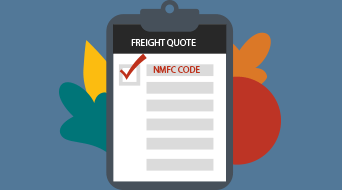Freight Class and NMFC Changes 2025: Everything You Need to Know
If you ship less-than-truckload (LTL) freight, you already know how important it is to understand your freight classification. And if you've been following the news, you've likely heard that some big changes have taken effect this year.
In July and August 2025, the National Motor Freight Traffic Association (NMFTA) rolled out the most significant updates to the National Motor Freight Classification (NMFC) system in more than 15 years. This major overhaul aims to simplify how freight is classified and make pricing more transparent — but it also changes how LTL shipments are rated, documented and handled.
In other words, a complex topic just got more complex. But don't worry, we'll break it down here in this FAQ. Whether you ship once a week or manage dozens of loads every day, here's what you need to know about freight class codes, how LTL freight classification works and what the NMFC changes 2025 mean for your business!
NMFC Freight Classification Basics
Here are answers to some basic questions that haven't changed much with the recent overhaul.
What is an NMFC code?
Let's start with the basics. The NMFC is a standardized set of codes managed by the NMFTA that helps determine your shipment's freight class code. Each code corresponds to a specific commodity or type of freight and outlines packaging rules, handling requirements and liability factors.
Essentially, an NMFC code tells carriers what you're shipping and how it should be handled — which then determines the correct LTL freight classification and rate.
Freight Class vs. NMFC: Are they the same thing?
Not quite, but they work together.
- The NMFC code identifies the commodity and outlines packaging and handling standards.
- The freight class is a numeric rating (from Class 50 to Class 500) that carriers use to calculate your shipping rate.
Most shipments are now classified by density using a 13-tier scale, with each tier linked to a specific freight class. The denser your shipment, the lower its class — and generally, the lower the rate. Density has become the primary driver behind both freight classification and NMFC codes, especially for general commodities.
What determines the NMFC code and freight class for a shipment?
As of July 2025, NMFC freight classification is primarily based on density-based groupings, rather than specific commodities. The new 13-tier scale ranges from class 50 (dense, easy-to-handle freight) to class 500 (lightweight, fragile or high-risk items).
While commodity type still plays a supporting role, the main factors now include:
- Density (weight per cubic foot)
- Stowability (how easily items can be stacked or stored)
- Handling (fragility, hazard, shape)
- Liability (value, perishability, theft risk)
Are NMFC numbers used worldwide?
No. NMFC codes are only used in the United States, Canada and Mexico.
For international shipments, carriers use harmonized system (HS) codes, which classify goods for customs and determine duties, taxes, and import/export restrictions.
How do I determine my shipment's freight class?
You'll need accurate measurements for your shipment's dimensions, weight and commodity details. From there, you can use:
- The ClassIT+ NMFC tool (available from NMFTA)
- An LTL freight class calculator
- Or your transportation management system (TMS), if it integrates NMFC data
If you partner with a third-party logistics (3PL) provider, their TMS likely already automates this process for you.
How do I calculate freight density?
Measure your shipment's length, width and height in inches and round to the nearest inch. Weigh it — including packaging — and then divide the total weight by the cubic footage.
You can also use a freight density calculator (like the one available from Unishippers) to make it simple. Accurate density ensures your freight is classified correctly and prevents costly reclassifications.
What do I do once I know my shipment's freight class?
Once you know the correct freight class code, include it on your quote request and bill of lading (BOL). Make sure all special handling requirements (like fragile, hazmat or non-stackable items) are correctly flagged. Proper classification ensures accurate rate quotes and helps you avoid billing surprises or penalties later on.
2025 NMFC Changes — and How They Affect You
If you're an LTL shipper adapting to the new NMFC changes 2025, here's what's different and how to stay compliant.
What are the biggest freight class changes?
Five key words summarize the overhaul: simplicity, density, flags, accuracy and ClassIT+.
- Simplicity: The new system consolidated more than 2,000 NMFC commodity listings into a density-based model. Once you get familiar with it, classifying freight will actually be simpler.
- Density: While NMFC still considers all four key factors (density, stowability, handling and liability), density now carries the most weight. Commodities without special handling or liability issues are classified solely by density under the new 13-tier scale.
- Flags: Digital handling flags have been introduced for fragile, hazmat and non-stackable freight. These flags help carriers manage how shipments are rated, stored and insured.
- Accuracy: Because density drives classification, accuracy matters more than ever. Incorrect or incomplete data can trigger reclassification penalties, fees or denied claims.
- ClassIT+: The old NMFC Item Lookup Tool has been retired. It's replaced by ClassIT+, a more advanced system offering improved search, updates and integration options. Note that it does require a paid annual license.
Will my shipments cost more or less now?
It depends on your freight's density and packaging:
- Dense, compact shipments may now qualify for lower rates.
- Lightweight or bulky shipments could move into higher-cost classes.
- Improperly flagged freight (like hazmat or fragile goods) could incur added fees or denied claims.
What can I do to avoid higher costs?
Two main strategies can help you keep shipping costs down under the new LTL freight classification system:
Be precise
Provide accurate measurements and packaging details. Use ClassIT+ or a TMS to classify shipments correctly and flag any special handling requirements.
Pack smart
The new NMFC density-based classification rewards efficient LTL packaging. The higher your density (pounds per cubic foot), the lower your freight class — and your rate. Try these packing tips:
- Use smaller cartons or reduce empty space.
- Stack items vertically when safe.
- Consolidate multiple boxes into one pallet.
- Choose pallet sizes that match your freight footprint.
What do I need to do to stay compliant?
Your next steps depend on how you manage LTL shipping today:
- If you don't partner with a 3PL: Invest in a modern shipping platform or ClassIT+ license, and make sure your systems reflect the 13-tier density scale and new digital handling flags.
- If you partner with a 3PL: Talk with your representative to confirm they're using ClassIT+ or an updated TMS that aligns with NMFC Codes 2025. Make sure your freight is being properly classified and flagged before tendering it to the carrier.
Do I need a ClassIT+ account?
Not necessarily — but it can be a big advantage. But remember, it is a paid service, and here is what you should consider:
- Infrequent shippers: You can rely on your 3PL or carrier for classification help, though affordable web-based plans may make sense if you occasionally audit freight classes.
- High-volume shippers: Strongly consider it. ClassIT+ gives you better control, transparency and the ability to audit or dispute classifications. API integration can even embed classification tools directly into your shipping systems.
Why is measurement accuracy even more important now?
Because under the new National Motor Freight Classification rules, density drives everything. Inaccurate measurements can lead to reweighs, reclassifications, penalties and accessorial fees.
Carriers depend on your data to make precise pricing and handling decisions, so investing in accurate measurement tools can quickly pay off.
How are special-handling shipments affected?
Special-handling freight — such as fragile, hazmat,or non-stackable items — now requires digital flags in your eBOL or TMS.
If these flags aren't applied correctly, your shipment could be misrated, delayed or denied in a damage claim. Make sure your shipping systems and partners support these new digital flagging requirements.
Freight Class Changes: The Bottom Line
The NMFC changes 2025 mark a major shift in how LTL freight classification works. By moving to a more density-based model, the system aims to be fairer, simpler and more consistent across the industry. But it also demands more precision from shippers.
Whether you use ClassIT+, a TMS or a freight class lookup tool, understanding your freight class codes and NMFC updates will help you:
- Prevent reclassification penalties
- Reduce billing disputes
- Keep your LTL shipping costs predictable and transparent
When in doubt, reach out to your logistics provider for guidance — and make sure every shipment starts with accurate measurements and the right classification.
Still have questions about the 2025 NMFC changes?
The recent updates to freight class rules are complex, but they also create opportunities to lower costs and streamline your shipping strategy. From packaging tips to reclassification audits, Unishippers offers expert support and technology to help keep you compliant — and competitive.
We have more than 30 years of success in the logistics industry and help thousands of shippers of all sizes move products with great efficiency. We are also part of WWEX Group, alongside Worldwide Express and GlobalTranz. Combined, these companies make up one of the largest and most diverse 3PLs in the industry, providing shippers with top solutions that help them succeed — whether shipping parcel or freight.
Ready to take the first step toward freight class optimization? Reach out today to request a custom consultation with a Unishippers shipping expert.


